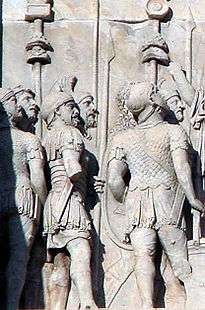Signifer

 | ||||
| Part of a series on the | ||||
| Military of ancient Rome | ||||
|---|---|---|---|---|
| Structural history | ||||
|
||||
| Campaign history | ||||
| Technological history | ||||
|
||||
| Political history | ||||
|
|
||||
| Strategy and tactics | ||||
|
||||
|
| ||||

A signifer was a standard bearer of the Roman legions. He carried a signum (standard) for a cohort or century. Each century had a signifer so there were 59 in a legion. Within each cohort, the first century's signifer would be the senior one.
Standard-bearer
The signum that he carried was the military emblem of that unit. It had a number of phalarae (disks or medallions) along with a number of other elements mounted on a pole. The pole could be topped with a leaf-shaped spear head or a manus (open human hand) image denoting the oath of loyalty taken by the soldiers. It sometimes included a representation of a wreath, probably denoting an honour or award.
The task of carrying the signum in battle was dangerous, as the soldier had to stand in the first rank and could carry only a small buckler. It was that banner that the men from each individual century would rally around. A soldier could also gain the position of discentes signiferorum, or standard bearer in training. If the signifer was lost in battle, the whole unit was dishonored.
Uniform
Contrary to popular belief, the signifers do not seem to have covered their helmets with wolf skins. The widespread use of wolf skins in the costumes of standard bearers in modern re-enactments cannot be defended in the light of the surviving sources: archaeological and literary sources indicate that standard bearers wore only bear and lion skins, and wolf skins are never mentioned.[1]
Banker
In addition to carrying the signum, the signifer also assumed responsibility for the financial administration of the unit and functioned as the legionaries' banker. He was paid twice the basic wage.
Roman Republic and Roman Empire
In the Roman Republic, the signifer probably applied to all standard bearers, but in the Roman Empire, the signifer was just one of a number of types of signiferi, which also included aquilifers, imaginifers, duplicarii, vexillarii and draconarii.
Sources
Zehetner, S. 2011: Der Signifer. Stellung und Aufgaben in der Kaiserzeitlichen Armee. VDM Verlag, Saarbrücken.
See also
- Aquilifer
- Imaginifer
- Vexillarius
- Draconarius
- Colours, standards and guidons
- List of Roman army unit types
References
- ↑ Mika Rissanen. "Was There a Taboo on Killing Wolves in Rome?". Quaderni Urbinati di Cultura Classica. Fabrizio Serra Editore. Retrieved 2016-11-10.